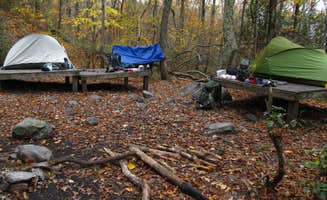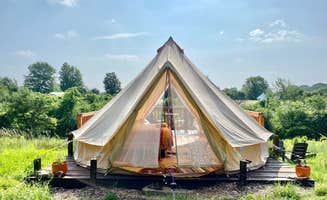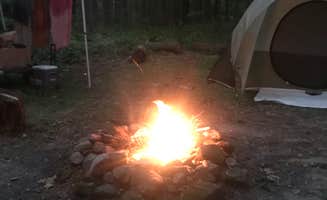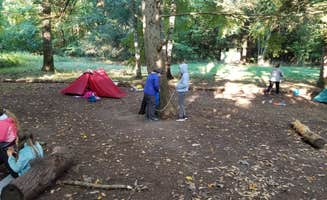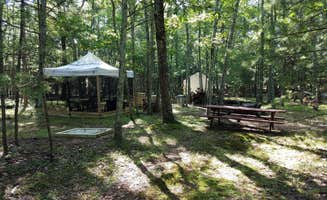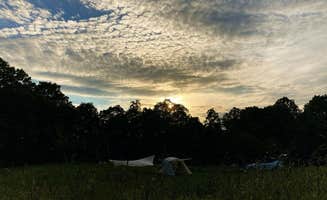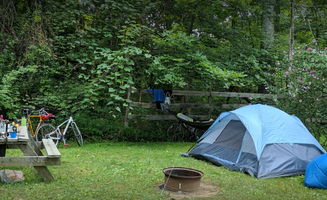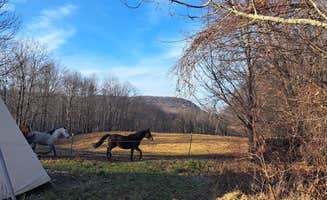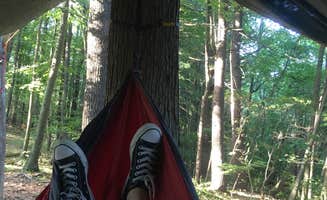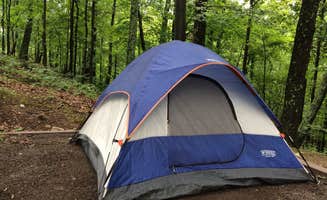Tent camping in Mount Washington, Massachusetts centers around remote, backcountry sites at elevations between 1,500-2,600 feet. The region receives approximately 55 inches of annual precipitation, creating lush forest environments but challenging weather conditions for campers. Most sites require significant hiking with full packs over rough terrain, with distances ranging from 1-3 miles from designated parking areas.
What to do
Explore mountain summits: The Bear Mountain summit trail connects to multiple camping areas including Brassie Brook Shelter, offering challenging hikes with substantial elevation gain. "We started our hike at the under-mountain trailhead, located right off route 41, and climbed up the mountain. Be prepared for steep inclines, and lots of rocks," writes Nora S.
Visit mountain lakes: Echo Lake provides waterside camping with multiple tent sites scattered around the shoreline. According to Kate, "There are tent sites around the whole lake with fire pits and 1 lean-to site at the end of the trail when you first arrive at the lake. The sites are relatively flat and well shaded with trees."
Trek through Sages Ravine: Located near Laurel Ridge campsite, this scenic ravine offers creek-side hiking opportunities. "We headed down Sages Ravine (awesome!) and towards/past Bear Mountain onto Undermountain Trail. This was overall no easy hike in any way, so if you are not in moderate shape I would not recommend this to you," notes Tina D.
What campers like
Privacy between sites: At Alander Trail Campground, the hike-in requirement keeps crowds minimal. Liz P. remarks, "What I liked most about this campground is that it wasn't overcrowded. Each spot is easy to find off the trail. They also have bear boxes at each site!"
Wildlife viewing opportunities: The forested settings provide chances to observe native wildlife, though proper precautions are necessary. "The area was emmaculate and not one piece of trash on the ground anywhere! The outhouse was even clean!" adds Liz P. about Alander Trail.
Expansive valley views: Mountain campsites reward hikers with scenic vistas overlooking the surrounding terrain. Tina D. describes Laurel Ridge: "The views once you get up there are nothing short of stunning and there is a short section of trail that's really the kind of spot that makes you go 'This is why I hike!'. There's a sheer drop-off of hundreds of feet spreading out into a massive valley scene below."
What you should know
Water planning essential: Most sites have no reliable water sources, requiring campers to carry all needed water or use filtration systems for natural sources. "It's quite a hike to get to this dispersed campground, so be prepared! We packed on our backpacks early in the morning and arrived there mid-afternoon," advises Nora S. about Laurel Ridge.
Bear activity present: Food storage requirements apply at most tent sites. "We had some scares with coyotes and bears in the past but never anything crazy. They give you a semi-flat area for a tent, a fire pit and grill rack, one picnic table, and a bear box you would be sharing with other campers nearby," reports Kay D.
No reservations available: Many campgrounds operate on a first-come basis, which can be challenging during peak season. "Can't make a reservation but beauitful camground that is about a mile hike from the trailhead," notes Annmarie J. about Alander Trail Campground.
Tips for camping with families
Choose appropriate hiking distances: Some sites require significant hiking that may challenge younger children. At Riga Lean-To, Nora S. recommends: "We absolutely loved this little lean-to next to Bear Mountain. Riga has the lean-to as well as about 4 or 5 sites all around. There's no picnic tables at the other spots but there is one for the lean-to."
Select elevated campsites: Higher ground provides better air circulation and fewer insects. James A. suggests at Echo Lake: "We camped on the hill with a beautiful view of the whole lake and breeze."
Pack light but thoroughly: With no vehicle access, everything must be carried in. "We ended up stumbling on this campsite on our way to the Riga lean-to, which was a very happy surprise. We started our hike at the under-mountain trailhead, located right off route 41, and climbed up the mountain," explains Nora S.
Tips from RVers
Limited RV options nearby: Most Mount Washington tent camping is hike-in only, but alternative options exist for RVers. At Chester Railway Station, campers find unique accommodations within driving distance. Esther L. notes, "It is a really fun place to spend a night, especially for a train enthusiast. The caboose is stationed on a big grassy field, near a real railroad. It sleeps 4 and you can set up tents outside too."
Consider base camps: RV campers can use established campgrounds as starting points for day hikes to remote areas. "It does get a little crowded later in the day so you may have to share space with others and it can be a little noisy at night," explains Kate about Echo Lake, where parking is more accessible.
Plan for limited facilities: Even at drive-in sites, amenities may be minimal. Sara R. describes Windmill Hill: "I booked site 5 for the week. Great experience! Quiet woods atmosphere with trail's. Wonderful place to camp. Very clean."


